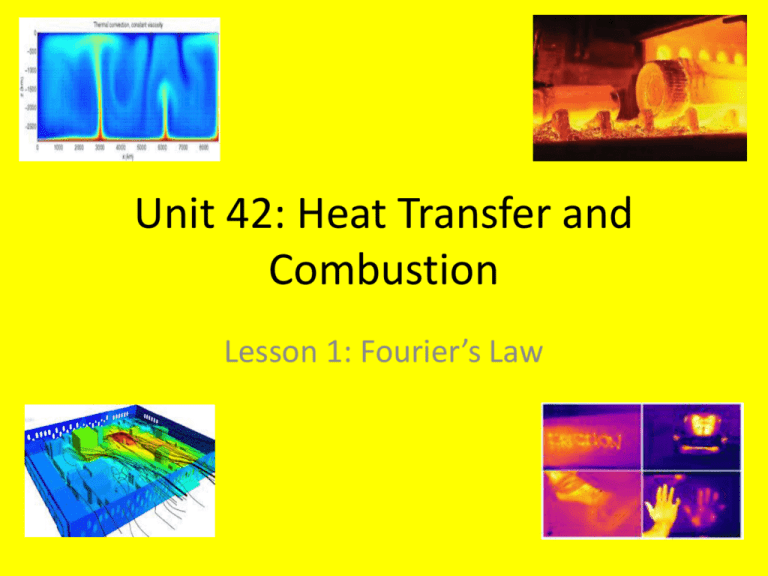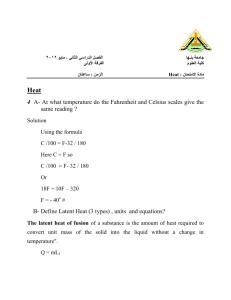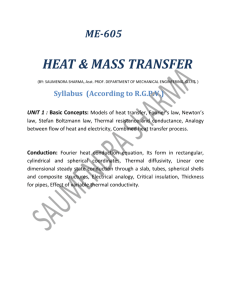File
advertisement

Unit 42: Heat Transfer and Combustion Lesson 1: Fourier’s Law Aim NDGTA • LO1: Understanding Heat Transfer Rates for Composite Systems. Conduction NDGTA • Thermal conduction in solids and liquids seems to involve two processes. The first is concerned with the movement of atoms and molecules. The second with free electrons. • Atoms at high temperature vibrate more vigorously about their equilibrium positions in the lattice than their cooler neighbours. Since atoms and molecules are bonded to one another, they pass on some of their vibration energy. Conduction NDGTA • This energy transfer occurs from atoms of high vibrational energy to those of lower vibrational energy, without appreciable displacement. • This energy has a knock-on effect, since high vibrational energy atoms increase the energy in adjacent low vibrational atoms, which in turn causes them to vibrate more energetically resulting in thermal conduction. Conduction NDGTA • The second process involves material with a ready supply of free electrons. Since electrons are considerably lighter than atoms, any gain in energy by electrons results in an increase in the electrons’ velocity and they are able to pass this energy on quickly to cooler parts of the material. Conduction NDGTA • Thus heat transfer by conduction involves two processes, one involving the energy transfer from high-energy vibrating atoms or molecules to those of lower energy and the second by the rapid transfer of energy between high-energy free electrons and their lower energy neighbours Conduction NDGTA • This is one of the reasons why electrical conductors which have many free electrons are also good thermal conductors • The way in which heat may be transferred by conduction may be modelled using Fourier’s Law. Fourier’s Law NDGTA • Whenever a temperature gradient exists in a solid material heat will flow from high temperature to the low temperature region. • The rate at which heat is transferred by conduction, dQ/dt is proportional to the temperature gradient dT/dx and the area A normal to the direction of heat transfer i.e. dQ/dt ∞ AdT/dx Fourier’s Law NDGTA • The constant of proportionality is called the thermal conductivity (k) of the material subject to the heat – Handout Table 17.1 p302 Eng Sci. • Thus k is an inherent property of the material to conduct heat Y Steady flow represented by straight line . T1 Area ‘A’ normal to heat flow Q = dQ/dt T2 Positive heat flow direction X X Fourier’s Law . NDGTA • Thus Q = - kAdT/dx • Note the (-) sign which results from the second law of Thermodynamics which essentially notes that heat flow from a higher temperature to a lower temperature in order for this flow to be positive (by convention) a minus sign is added here. • This relationship was first determined by a French Mathematician Fourier and as it has never been disproven its referred to as Fourier’s Law Fourier’s Law NDGTA . • Provided that the whole heat flow Q (J.s-1) is steady and perpendicular to the surface through which it travels and the surface temperatures remain constant, then the temperature gradient dT/dx may be expressed in terms of the change in temperature (T2 – T1) and the distance x across which the temperature change takes place, then . Q = - kA(T2 – T1)/x or = kA(T1 – T2)/x Fourier’s Law NDGTA • Another useful variant is to express conduction in terms of the rate of. heat transfer per unit area (q) i.e. q = Q/A • The quantity q has the units of W.m-2. and is often referred to as the heat flux. Thus q = k(T1 – T2)/x Fourier’s Law NDGTA • The outer surface temperature of a pane of glass is 15oC and its inner surface temperature is 25oC. Calculate the rate of heat loss through the pane of glass given that its thermal conductivity is 0.8 W/m.K and it has dimensions of 1.0 m high, 0.5m wide and 0.75cm thick. Fourier’s Law NDGTA • Assume steady state conditions prevail • Only consider conduction in the x-direction through the glass • The glass is homogeneous (i.e. constant properties throughout) . Q = k(T1 – T2)/x = (0.8)(0.5)(25 – 15)/0.0075 = 533.33 W • Note the heat flux q = 1066.67 W/m2.


![Applied Heat Transfer [Opens in New Window]](http://s3.studylib.net/store/data/008526779_1-b12564ed87263f3384d65f395321d919-300x300.png)


